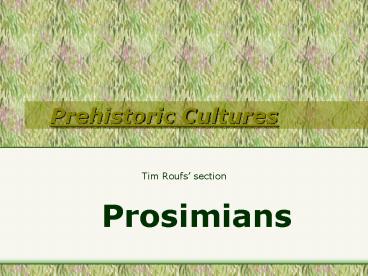Prehistoric Cultures - PowerPoint PPT Presentation
Title:
Prehistoric Cultures
Description:
Title: PowerPoint Presentation Author: Timothy G. Roufs Last modified by: Tim Roufs Created Date: 6/25/2000 8:57:16 PM Document presentation format – PowerPoint PPT presentation
Number of Views:113
Avg rating:3.0/5.0
Title: Prehistoric Cultures
1
Prehistoric Cultures
- Tim Roufs section
Prosimians
2
- http//www.d.umn.edu/cla/faculty/troufs/anth1602/p
cprim.htmlProsimii
3
Classification chart (after Linnaeus)
Understanding Physical Anthropology and
Archaeology, 9th ed., p. 96
4
Prosimians (pre-monkeys)
Primate taxonomic classification
Understanding Physical Anthropology and
Archaeology, 9th ed., p. 123
5
Taxonomy
Common Name
Suborder
- Prosimii
- tree shrew (insectivore)
- lemur
- loris
- tarsier
Anthropoidea
6
Taxonomy
Common Name
Suborder
- Prosimii
- tree shrew (insectivore)
7
(Pen Tailed) Tree Shrew, Borneo
- REM the tree shrew is an insectivore not a
primate - S.E. Asia and Indonesia
8
Borneo
Indonesia
Java
Indonesia and Borneo
Understanding Physical Anthropology and
Archaeology, 9th ed., p. 126
9
(Pen Tailed) Tree Shrew, Borneo
- REM the tree shrew is an insectivore not a
primate - S.E. Asia and Indonesia
- sharp-clawed digits
- old fossil forms show flattened nails
- some are nocturnal
- about the size of a squirrel
- approximation of earliest phase in the evolution
of primates
10
Pen Tailed Tree Shrew, Borneo
p. 126
The Primates, Time-Life (1974) p. 20
11
Taxonomy
Common Name
Suborder
- Prosimii
- tree shrew (insectivore)
- lemur
12
Lemur
Primate taxonomic classification
Understanding Physical Anthropology and
Archaeology, 9th ed., p. 123
13
Modern Lemurs
Madagascar
Geographical distribution of modern lemurs
Understanding Physical Anthropology and
Archaeology, 9th ed., p. 125
14
(Dwarf) Lemur, Madagascar
- size and appearance of a raccoon
- independently moveable ears
- mostly nocturnal
- approximate midpoint between insectivores and
monkeys - widespread during Eocene, and is of interest
because of little change since Eocene - (36-58 million yrs. B.P.)
- most digits have flat nails rather than claws
- has uneven body temperature
15
(Dwarf) Lemur, Madagascar
p. 125
The Primates, Time-Life (1974) p. 12
16
Ring-tailed lemur
p. 125
Understanding Physical Anthropology and
Archaeology, 9th ed., p. 125
17
Sifakas in their native habitat in Madagascar
p. 125
Understanding Physical Anthropology and
Archaeology, 9th ed., p. 125
18
p. 125
19
p. 125
Lemur, Madagascar
20
p. 125
21
Taxonomy
Common Name
Suborder
- Prosimii
- tree shrew (insectivore)
- lemur
- loris
22
Loris
Primate taxonomic classification
Understanding Physical Anthropology and
Archaeology, 9th ed., p. 123
23
Loris
- Malaysia, S.E. Asia
24
Malaysia
Malaysia
Java
Understanding Physical Anthropology and
Archaeology, 9th ed., p. 126
25
Loris
- Malaysia, S.E. Asia
- nocturnal
- large eyes
- feeds largely on insects, birds, and birds eggs
- strong hands
- backbone has more vertebrae than any other primate
26
Loris, Malaysia
p. 126
The Primates, Time-Life (1974) p. 29
27
Slow loris
p. 126
Understanding Physical Anthropology and
Archaeology, 9th ed., p. 126
28
Taxonomy
Common Name
Suborder
- Prosimii
- tree shrew (insectivore)
- lemur
- loris
- bush baby
29
Galago, or bush baby (Lorisiforme)
p. 126
Understanding Physical Anthropology and
Archaeology, 9th ed., p. 126
30
Taxonomy
Common Name
Suborder
- tree shrew (insectivore)
- lemur
- loris
- bush baby
- tarsier
- Prosimii
31
Tarsier
Primate taxonomic classification
Understanding Physical Anthropology and
Archaeology, 9th ed., p. 123
32
Tarsier
- North central Indonesia
33
Modern Tarsiers
Borneo
Indonesia
Java
Geographical distribution of modern tarsiers
Understanding Physical Anthropology and
Archaeology, 9th ed., p. 126
34
Tarsier
- North central Indonesia
- extreme development of tarsal bones
- smaller than lemur, about the size of a rat
- small nose, large goggly eyes
- at least 25 genera in Eocene times
- (36-58 million yrs. B.P.)
- today there is only one
- arboreal
- nocturnal
- 180 degree head swivel
35
Tarsier, Indonesia
p. 126
The Primates, Time-Life (1974) p. 23
36
Tarsier
p. 126
Understanding Physical Anthropology and
Archaeology, 9th ed., p. 126
37
Primates
- Earliest primates
- Prosimians
- (pre-monkeys)
38
Prosimians
Primate taxonomic classification
Understanding Physical Anthropology and
Archaeology, 9th ed., p. 123
39
A Primate Family Tree
The Emergence of Humankind, 4th ed., p. 64
40
New World Monkeys
Old World Monkeys
ca. 50 mya
41
Next
Monkeys
Understanding Physical Anthropology and
Archaeology, 9th ed., p. 123































